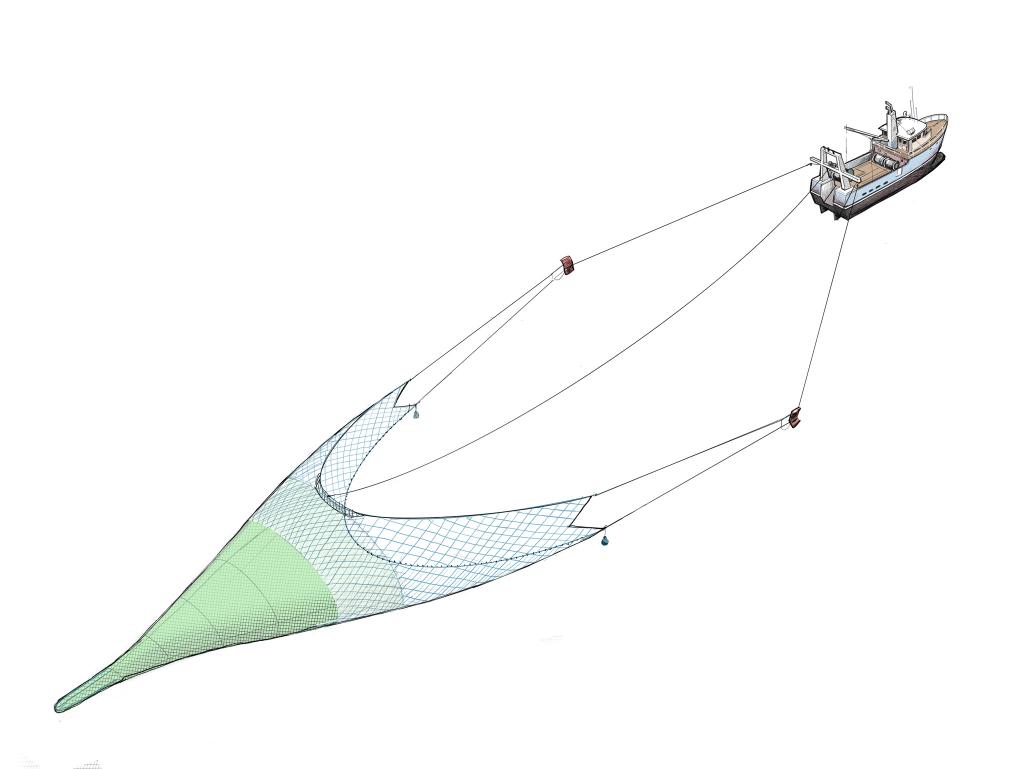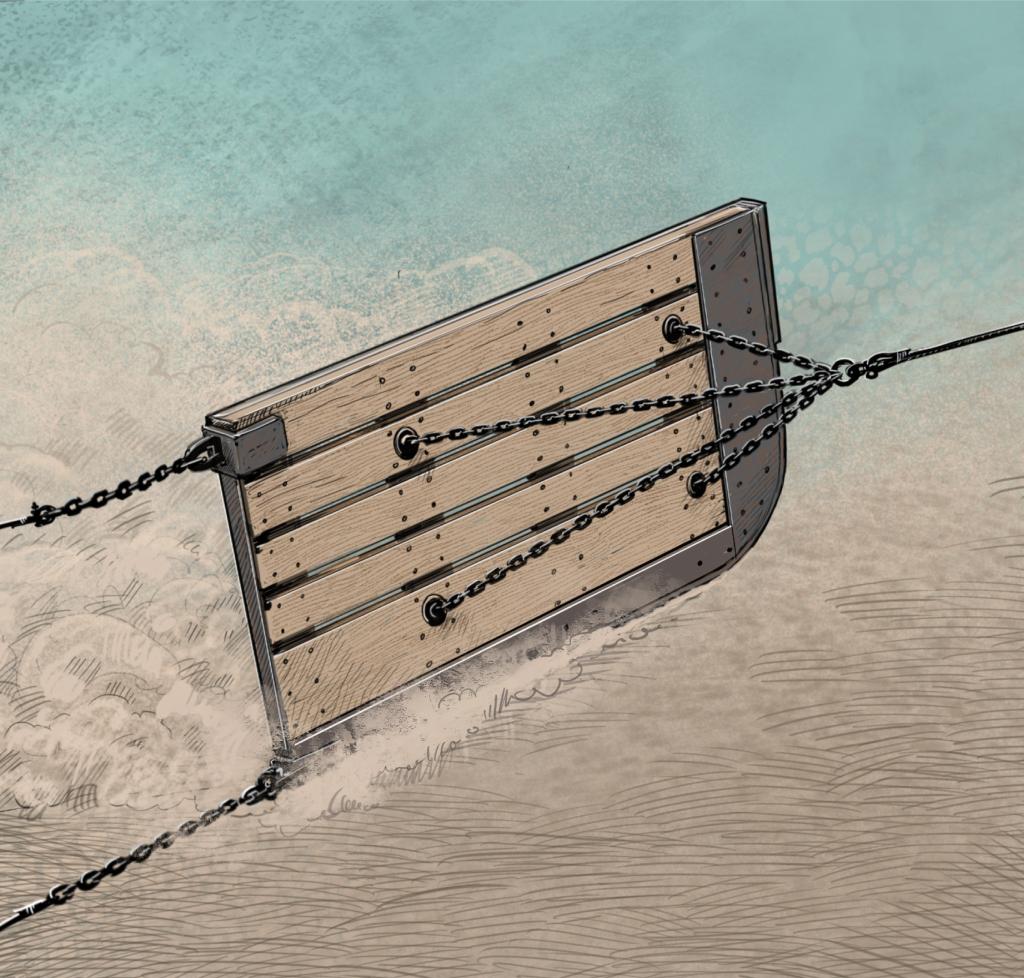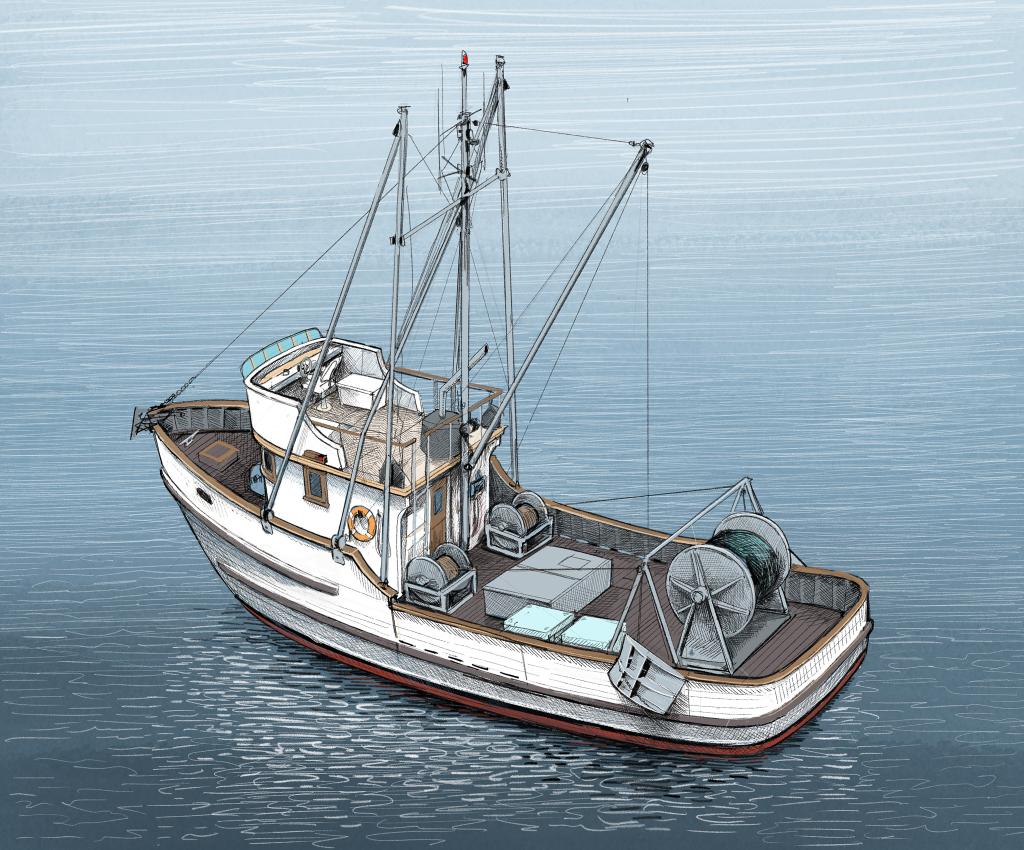
A trawl is a funnel shaped net that is towed through the water. The net tapers to a narrow section called the codend, where the catch is collected. Trawls have floats attached to the top of the net and lead lines at the bottom to keep it in position in the water. They also have "doors” on the sides of the net to keep it spread open during fishing. Several West Coast fisheries use trawl nets.
Midwater groundfish trawls
Midwater (or "pelagic") trawls have little to no contact with the ocean bottom and are used to fish mostly for Pacific whiting off the coasts of Oregon and Washington. There is also a limited midwater trawl fishery for rockfish, including widow and yellowtail rockfish, which is all delivered to shoreside processors. Whiting vessels are generally larger than other trawl vessels, but range in size depending on whether they also have seafood processing facilities onboard. Many West Coast midwater trawler “catcher vessels” also deliver to shoreside processors in major fishing ports. Some catcher vessels deliver to floating seafood processor vessels called motherships. The largest vessels both catch and process fish and are aptly called catcher-processors.
Pink shrimp and ridgeback prawn trawls
Pink shrimp trawl gear uses a “double-rigged" setup with two funnel shaped nets, one on each side of the vessel, towed at the same time from large outrigger poles. Ridgeback prawn trawl gear uses a “single-rigged” funnel-shaped net towed from the stern of the vessel. Nets are towed just above the seafloor and use a “tickler” chain that causes shrimp to swim up and into the net.

The nets are held open by doors. The shrimp become trapped in the net, which is then pulled to the surface using a net reel. Once the net is on board, pink shrimp are emptied into a “hopper,” sorted, transferred into a fish hold and immediately iced. Ridgeback shrimp are transferred to totes filled with fresh seawater and iced in the fish hold, or, if being sold live, an insulated live well with fresh seawater pumped with oxygen.
Shrimp nets have a small mesh size to retain shrimp, and a number of features to minimize bycatch. Nets are required to have excluder devices (also known as bycatch reduction devices or grids) to avoid bycatch of larger fish such as rockfish. For pink shrimp nets, LED lights attached to the foot rope deter smaller non-target species like smelt from entering the net.



Bottom groundfish trawls
Groundfish is a term describing a group of 90+ species found on or near the seafloor that are managed together.
Bottom groundfish trawls target groundfish such as sablefish, sole and flounder (flatfish), and rockfish. As with other trawl fisheries, the net is held open with “doors.” Rubber discs placed along the net’s footrope (bottom net opening) stabilize the net and hold it off of the ocean bottom. Size restrictions on the discs limit trawling to smooth seafloor areas, such as sand and mud. Nets have different mesh sizes (openings in the net) depending on the type of fish they are targeting, as well as a variety of designs and excluder devices to limit bycatch of unwanted species. After a tow, the crew hauls in the net, releases the catch onto the deck, sorts the fish, and transfers them into the fish hold where they are iced or refrigerated. If the crew are continuing to fish, they will set the net for another tow and sort while underway.

To protect groundfish species and their habitat, federal and state fishery managers set strict quotas limiting the number and size of fish that are caught, and close some areas to fishing.
California halibut trawls
California halibut trawlers use two different types of trawl gear depending on where they are fishing. If they are fishing far (more than three miles) from shore they use groundfish bottom trawl gear as described above. Fishing within three miles of shore is prohibited in nearly all parts of California except for three designated areas called the California Halibut Trawl Grounds in the south-central part of the state. In these state-designated trawl grounds, only light touch trawl gear is allowed to be used. This gear is similar to shrimp trawls, with a “tickler” chain that lightly touches the ocean bottom, causing halibut to swim up and into the net while minimizing disturbance to the seafloor. As halibut are much larger than shrimp, the mesh size of halibut trawl nets is also much larger.
Giant red sea cucumber trawls
Giant red sea cucumber trawlers use two of the previously described types of trawl gear depending on where they are fishing. If they are fishing more than three miles from shore, they use shrimp trawl gear. If they are within three miles of shore in the California Halibut Trawl Grounds, they use light touch halibut trawl gear.
